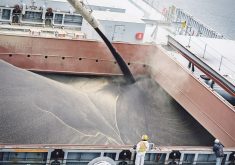Brazilian soybeans are no longer the incredibly growing crop.
Not only has Brazilian soybean acreage and production stopped its furious pace of expansion, but many experts forecast that the country’s soybean crop, to be sown in September, will fall by two to five million acres in favour of other crops or even summerfallow.
Farmer protests over transportation costs and snarls and widespread financial problems have affected the crop’s prospects.
But no one should expect to see Brazil retreat from the world soybean market, said American agriculture policy analyst Darryl Ray of the University of Tennessee.
Read Also

Russian wheat exports start to pick up the pace
Russia has had a slow start for its 2025-26 wheat export program, but the pace is starting to pick up and that is a bearish factor for prices.
“I expect many of their problems are more likely to be short term instead of long term,” said Ray, who visited the country this spring and saw the problems up close.
“The potential is so great for increasing agricultural production in the non-Amazon areas that if they get profitable prices again, they will be expanding.”
Brazilian soybean production has been hurt by the growing pains of its sudden massive expansion. Recently, Oil World magazine estimated that 2006-07 acreage will drop by two to five million acres, with other experts concurring. Five million acres would be about six percent of last year’s base of 54 million acres, and would produce a crop of 50 to 54 million tonnes based on trend yields. In recent years many experts predicted Brazilian soybean production to rise above 60 million tonnes per year, so this would be a dramatic reversal.
Soybean production is being undermined by the jump in the relative value of the Brazilian currency, called the real, versus the United States dollar. While the Canadian dollar’s increase in value has been impressive, the Brazilian currency has risen even more, driving Brazilian farmgate soybean prices below breakeven for many farmers.
At the same time, booming demand for sugar cane is drawing acreage out of soybeans. Brazil’s huge ethanol industry uses sugar cane as its main fuel stock, and as world fuel prices have risen, so has its value.
World cotton prices are also relatively more attractive than soybeans, so farmers who can afford to seed that crop instead, will likely do so, Ray said.
As well, soybeans are often hamstrung by a snarled grain transportation infrastructure, making it costly to ship crops to port.
Soybeans are also likely to get fewer inputs than the crop needs because many farmers have spent all their credit and can’t finance more for fertilizer or Asian rust fungicides. Many crops will be neglected, experts say.
But Ray said the raw agricultural potential is too great for these problems to permanently curtail Brazilian agricultural production. Farmers may be set back a few years, but progress is occurring even today.
“I think once economic conditions improve, we’ll see them grow again,” said Ray.
“They’re developing new varieties of crop and building their livestock industry too. I think (these current problems) are more than just a bump in the road, and it might take them a while to get this all straightened out, but a permanent reduction? I think that’s more (wishful thinking by competitors) than reality.”
However, there is one area where Ray thinks Brazil’s problems will worsen and that is expansion through the Amazon rainforest.
He toured the giant Cargill port facility at Santarem on the Amazon and said local, regional and international opposition is so great to agricultural development in the environmentally sensitive area that the port and export channel is likely to be a white elephant.
“It’s extremely underutilized,” said Ray.
“They promised, and overpromised, the positive impact that it would have on the city there.”
Local people are unhappy with the port megaproject and many important international customers and domestic users of Brazilian soybeans have said they will not accept soybeans that pass through the Amazon, Ray said.
But apart from suffocating the Amazon route, Brazil’s soybean production will almost certainly return to the path of expansion.
“It’s going to be not just more soybean production but also more corn production and livestock production,” said Ray. “I would not sell Brazil short in the long term.”















